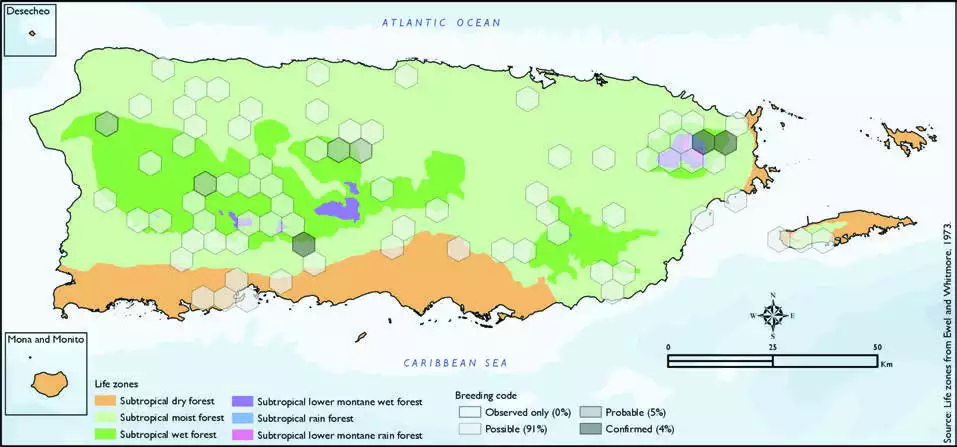Ruddy Quail-Dove
Description
The ruddy quail-dove (Geotrygon montana) is a species of bird in the dove and pigeon family Columbidae. It breeds throughout the West Indies, Central America, and tropical South America. It has appeared as a vagrant in Florida and southern Texas. It lays two buff-colored eggs on a flimsy platform built on a shrub. Some nests are built on the ground.
The ruddy quail-dove is approximately 19–28 cm in length. The bird is distinguished by having a rust-colored back, facial mask and similarly colored wings. The breast, rump and undereye stripe are lighter brown.
Distribution & Habitat
The Ruddy Quail-Dove breeds from Mexico to Brazil and
throughout the West Indies
(Raffaele and others 1998). In
Puerto Rico, it has been reported
from Maricao and Carite State
Forests (Bowdish 1902, Oberle
2018), all forested areas at
lower elevations of the Sierra
de Luquillo (Recher and Recher
1966), and Mona (Terborgh and
Faaborg 1973). It is described
as extremely rare on Vieques
(Gemmill 2015). This species
usually inhabits humid and
heavily forested areas among
the hills and mountains, and it is common in coffee, citrus, and
cacao plantations (Bond 1961,
Oberle 2000, Raffaele 1989a).
It is associated with dense
forests with a well-developed
understory (Oberle 2018), as
it dwells mostly on the forest
fl oor (Raffaele 1989a). The atlas
fieldwork yielded a total of 97
records within 77 hexagons or 16
percent of the 479 total hexagons
(see map). Of the 77 hexagons
where this species was found,
breeding met the atlas definition
of confirmed in 4 percent (3)
of the hexagons, probable in 5
percent (4), and possible in 91
percent (70) (see map). Ruddy Quail-Dove distribution. The map shows the highest breeding code by hexagon and overlaying the ecological life zones in
Puerto Rico. Note: percentages may not total 100 due to rounding. 55Ruddy Quail-Dove/Paloma Perdiz Rojiza

Breeding Habits
The Ruddy Quail-Dove builds nests made of twigs and leaves,
usually low on fallen trees
or small shrubs (Biaggi 1997,
Raffaele 1989a). The nests are
commonly constructed near or
on the ground, and previously
published reports indicate that
breeding occurs from February
to August (Raffaele 1989a).
Nevertheless, atlas results show
that this species breeding season
extends throughout the year,
with the most breeding activity
in April, May, and June (see
chart). Results show that this species breeds mostly within the
subtropical moist forest life zone
(53 percent of the hexagons),
as well as in subtropical wet
and lower montane wet forest
life zones (36 percent of the
hexagons) to a lesser extent
(see table and map). Most of the
confirmed breeding records are
from the Sierra de Luquillo.
Conservation
This species is currently listed as a species of least concern by
the IUCN (BirdLife International
2016). However, it is predicted
to lose 16.518.7 percent of suitable habitat within its
distribution range over three
generations, or around 14
years, based on Amazonian
deforestation model projections
(Bird and others 2012, Soares-
Filho and others 2006). Locally,
this species is not listed in any
of the threatened categories of
PRDNER and USFWS. In Puerto
Rico, the Ruddy Quail-Dove has
a protected habitat in land of 25
percent or 455 km2 of the total area covered by the hexagons
where evidence of breeding
was found for this species
(1842 km2).
Related Species
Family:
dove